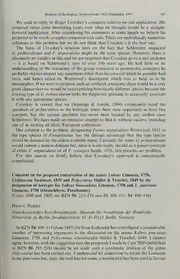
On the proposed conservation of the names Labrus Linnaeus, 1758, Cichlasoma Swainson, 1839 and Polycentrus Mueller & Troschel, 1849 by the designation of neotypes for Labrus bimaculatus Linnaeus, 1758 and L. punctatus Linnaeus, 1758 (Osteichthyes, Percifo PDF
Preview On the proposed conservation of the names Labrus Linnaeus, 1758, Cichlasoma Swainson, 1839 and Polycentrus Mueller & Troschel, 1849 by the designation of neotypes for Labrus bimaculatus Linnaeus, 1758 and L. punctatus Linnaeus, 1758 (Osteichthyes, Percifo
Bulletin ofZoological Nomenclature 54(31 September 1997 187 We wish to reply to Roger Crosskey's comment (above) on our application. His proposal raises some interesting issues over what we thought would be a straight- forward application. After considering his comments at some length we believe his proposaltobeoverlycomplexcomparedwithours.Thereareundoubtedlynumerous solutions to this problem but we do not think that Crosskey's is the best one. The basis of Crosskey's solution rests on the fact that Schletterer suspected G. pedumidcitum and F. imguiculatus might be the same species. However, there is —absolutely novalidity inthisand weare surprisedthatCrosskeygivesit anycredence it is based on Schletterer's view of over 100 years ago. He had little or no understanding ofthe taxonomy ofthe group compared to present-day concepts: he probablydid notinspect any specimens otherthanhisown (ofwhichhepossiblyhad two), and hence relied on Westwood's description which was so brief as to be meaningless. Ifweweretoproposesuch an artificial synonymytherewould beavery goodchance thatwewouldbesynonymisinghistoricallydifferent speciesbecausethe existingtypeofG.pedunadatiimlacks thediagnosticgenitalia to accurately associate it with any taxonomic species. Crosskey is correct that we (Jennings & Austin. 1994) erroneously listed the specimen oipedunndatus as the holotype when there were apparently at least two syntypes. but the second specimen has never been located by any author since Schletterer. We have madeanextensive attempt to findit, without success, including one ofus visiting all likely European collections. Our solution to the problem, designating Foemis imguiculatus Westwood, 1841 as the type species of Pseudofoenus. has the distinct advantage that the type species would bedenoted by the oldest available name. Certainly the name G. pedunculatum would remain a nomendubium but, sinceit is inevitablyinvalid as ajuniorsynonym ofeither F. unguiculatus or ofF. crassipes Smith, 1876, this presents no problem. For this reason we firmly believe that Crosskey's approach is unnecessarily complicated. Comment on the proposed conservation ofthe names Labrus Linnaeus, 1758, Ckhlasoma Swainson, 1839 and Po/ycentrus Miiller & Troschel, 1849 by the designation ofneotypes for Labrus bimaculatus Linnaeus, 1758 and L.punctatus Linnaeus, 1758 (Osteichthyes, Pereiformes) (Cases 2880 and 2905; see BZN 50: 215-218 and 53: 106-111: 54: 106-116) Hans-J. Paepke Naturhistorisches Forschungsinstitut. Museumfur Naturkunde der Humboldt- Universitat :u Berlin. Irnxdidenstrasse 43. D-10115 Berlin, Germany InBZN54: 109-115(June 1997) DrSven KuUanderhascontributedaconsiderable number of interesting arguments to the discussion on the names Labrus punctatus Linnaeus, 1758 and Polycentrus schomburgkii Miiller & Troschel, 1849. I cannot agree,however,withhissuggestionthattheproposalsImadeinCase2880(published in BZN 50: 215-218) should be set aside until a systematic revision of the genus Polycentrus has been carried out. I understand his endeavour to retain the Linnaean namepunctatusbut, sincethewellknownnameschomburgkiihasbeen usedinfavour ) 188 Bulletin ofZoological Nomenclature 54(3) September 1997 ofthecompletelydisregardedseniorname, and hasremainedunchallengedin usefor 134 years (from 1849 to 1983), I wish to stand by my proposal to conserve the name sclwinburgkii. The nomenclatural stability of schomhurgkii has been supported by Drs Fricke& Ferraris(Case 2905, published in 53: 106-111)and by ProfessorReeve Bailey in his comment on these cases (BZN 54: 106-109). Kullander (BZN 54: 110) doubts that the name schomhurgkii merits protection. 1 have therefore surveyed the frequency with which the name has been used in the literature for Schomburgk's leaf fish in the last 50 years (1947-1997) compared with that of pumtatus. Including the references which I cited in my application (BZN 50; 216, 217), I found that the name sclwinburgkii (sometimes incorrectly written 'schomhurgkC) has been used as valid in at least 54 publications by 53 authors during that time (I have given a list to the Commission Secretariat). Kullander has already pointed out that the taxon is referred to in aquarium and behaviour articles and books, and the name is therefore well known to the public. Many of the popular science publications 1 have listed are in German; it is to be expected that there is additional literature in other languages. In contrast, the name punctatus has been used only by Kullander (1983). Nelson (1984) and Stawikowski (1992). Referring in his comment (BZN 54: 110) to freshwater fish in Guiana. Kullander followed Kullander&Nijssen(1989)in recordingthat"thereisconsiderablediversity, with closely related species replacingeach otherin parallel riverdrainages". It isthus ofsignificance to note that the type locality ofP. schomhurgkiiis the Essequibo river drainage in the former British Guiana, whilst the type locality of Labruspunctatus was given by Linnaeus (1758) as "Surinami" in the former Dutch Guiana, another regionofGuiana. Itisconceivablethat inthefutureP. schomhurgkiiandL.punctatus may turn out to be distinct taxa and in view of this I now propose to revise my application to request that the nameschomhurgkii Miiller& Troschel, 1849 be given precedence overpunctatus Linnaeus, 1758, rather than thatpunctatus be suppressed, so that the latter can continue to be of use, if required, as a specific or subspecific name. If this revised proposal is approved by the Commission both names will be placed on the Official List. Kullander (BZN 54: 110. para. (4)) pointed out that "L. punctatus has been considered the type species of both Polycentrus Miiller & Troschel, 1849 and Cichlasoma Swainson. 1839". Under the Code (Article 68). P. schomhurgkii is. of course, thetypespeciesofPolycentrusand hasbeencitedassuchby Kullander(1983. p. 84). Eschmeyer& Bailey (1990, p. 325), and Fricke & Ferraris in their application (BZN 53: 107). The International Commission on Zoological Nomenclature is accordingly asked: (1 to use its plenary powers to rule that the specific nameschomhurgkiiMiiller& Troschel, 1849, as published in thebinomen Polycentrusschomhurgkii, is to be mme given precedence over the punctatus Linnaeus, 1758, as published in the binomen Lahruspunctatus; (2) toplaceon theOfficial List ofSpecificNamesin Zoology thefollowingnames: {d) schomhurgkii Miiller & Troschel, 1849, as published in the binomen Polycentrus schomhurgkiiand as defined by the syntypes in the Zoological Museum ofthe Humboldt-University ofBerlin, with theendorsement that it is to be given precedence over the name punctatus Linnaeus, 1758, as
